The Birthstone for October 25: Insights and Significance

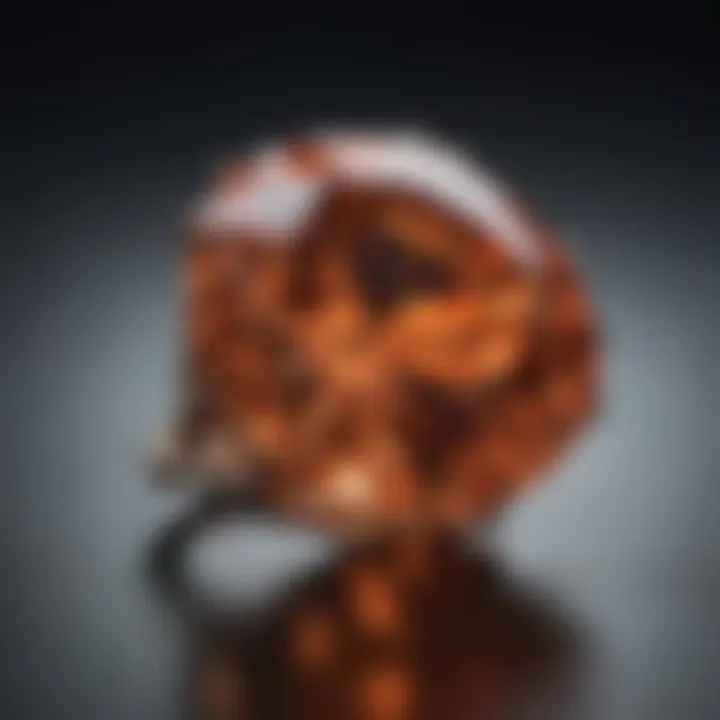
Intro
October 25 marks a special day for those born in this month, as it has its own unique birthstone. Understanding the gemstones associated with this date reveals more than just their beauty; it opens a window into their historical significance and cultural importance. This article aims to provide a comprehensive overview of the birthstone for October 25, examining its properties, meanings, and uses in various contexts. Whether you are a gemstone enthusiast, a collector, or someone interested in jewelry design, this exploration will shed light on the fascinating aspects of this particular stone.
Gemstone Overview
Definition and Origins
The birthstone for October 25 is Opal. Opal is known for its unique play of color, which makes it one of the most sought-after gemstones. This stone has a rich history, originating from several regions around the world, with Australia being the most prominent source. The word opal comes from the Latin opalus, and its history goes back to ancient civilizations where it was treasured for its beauty and believed properties.
Historical Significance
Historically, Opal held significant value across different cultures. Ancient Romans regarded it as a symbol of hope and purity, while in Middle Ages Europe, it was thought to bestow the virtues of all gemstones upon its wearer. Interestingly, some cultures associated Opal with bad luck, believing that its shifting colors mirrored human emotions. Despite mixed perceptions, Opal has maintained its allure throughout history.
Gemstone Properties
Hardness and Durability
The Mohs hardness scale helps categorize Opal as a stone that ranges between 5.5 to 6.5. This means it is somewhat soft in comparison to other gemstones. While Opal is durable in settings like rings, care must be taken since it can be prone to scratching.
Color and Clarity
Opals are particularly noted for their vibrant color play, which can include a spectrum of hues such as blue, green, orange, and red. The clarity of Opal varies, with some stones exhibiting transparent qualities while others are opaque. This gemstone's unique feature of displaying different colors when viewed from various angles is known as opalescence, making it a captivating choice for jewelry.
"Opal is often described as a kaleidoscope of color, making each gemstone truly unique."
Understanding these properties not only enhances appreciation for Opal but is also crucial for collectors and designers when selecting and working with this remarkable gemstone.
Prologue to October Birthstones
Understanding October birthstones is essential for those interested in gemstones, whether as collectors, designers, or enthusiasts. The significance of birthstones goes beyond their visual appeal and encompasses cultural, emotional, and historical dimensions. This article delves into the unique qualities of the gemstones associated with October, primarily opal and tourmaline, laying a foundation for readers to appreciate their multifaceted nature.
Defining Birthstones
Birthstones are gems traditionally linked to each month of the year, believed to bring luck and charm to individuals born within that month. The concept has ancient roots, connecting gemstones to astrological signs and cultural beliefs. Each birthstone carries certain properties and symbolism, offering wearers various benefits. For October, the primary gemstones are opal and tourmaline.
Opal is known for its vibrant play of colors, while tourmaline comes in a spectrum of hues. These stones share a common theme of emotional significance, often associated with uplifting energies and healing powers. Their specific features and properties make them ideal choices for jewelry and personal adornment.
The Significance of October
The date of October 25 holds particular significance for those who celebrate their birthdays on this day. The birthstone associated with this date amplifies personal traits such as creativity, emotional depth, and intuition. Individuals born on this date may experience unique connections to their gemstones, often finding themselves drawn to opal or tourmaline for inspiration and comfort.
Moreover, the significance of October 25 extends into various cultural practices and interpretations. Different communities might bestow varied meanings on the gemstones relevant to this date. As people engage with their birthstones, they often reflect on these personal and cultural connections, enhancing their understanding of identity and heritage.
In summary, the exploration of October birthstones is more than a mere inquiry into minerals; it is an engagement with tradition, personality, and sometimes mysticism. Understanding these aspects can enrich one’s experience and appreciation of gemstone collection or jewelry design.
Primary Birthstones for October
The exploration of October's primary birthstones, opal and tourmaline, reveals their unique characteristics, cultural significances, and healing properties. This month is particularly notable for its vibrant array of gemstones, and understanding the nuances of each can greatly enhance one’s appreciation for these stones. For gemstone enthusiasts, collectors, and jewelry designers, the choice between these two stones is not simply aesthetic; it also involves considering their historical context and metaphysical properties, which can influence personal connection and choice in gemstones.
Opal: Geological and Historical Insights
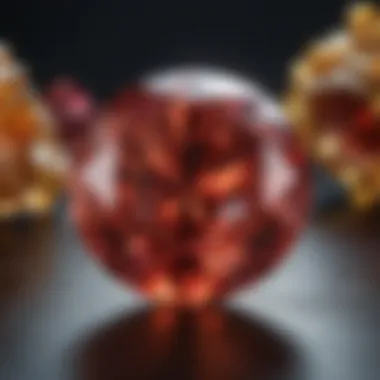
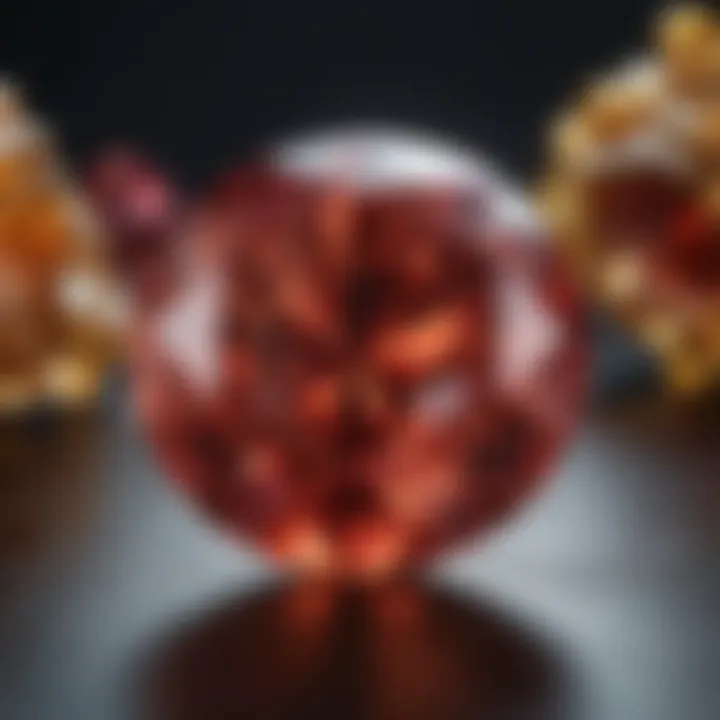
Opal, with its mesmerizing play of color, captivates many. Found primarily in Australia, this gemstone is composed of hydrated silica. Its formation occurs in extremely varied conditions, leading to multiple types based on location and environment.
Historically, opals have held a significant place in various cultures. Ancient Romans believed in the gemstone's ability to confer protection and luck. Notably, the stone was treasured for its supposed magical properties and ability to inspire creativity. These attributes make opal not just a decorative choice but also a symbol of aspiration and inspiration across centuries.
Tourmaline: Varieties and Characteristics
Tourmaline is celebrated for its wide spectrum of colors, ranging from vivid greens to deep blues and even multi-colored specimens. This versatility stems from the presence of various trace elements within its crystalline structure. The most celebrated type is the pink tourmaline, often associated with compassion and emotional healing.
Each color variant carries its own symbolism. For example, the green tourmaline is linked to empathy, while the blue is thought to promote calmness and peace. Its grounding qualities are appreciated by many, which adds depth to its appeal for collectors.
Comparative Analysis: Opal vs. Tourmaline
When comparing opal and tourmaline, one observes distinct differences and advantages.
- Visual Appeal: Opal’s play of color is unique and captivating, making each piece one-of-a-kind. In contrast, tourmaline offers a broader spectrum of colors but with more uniform visuality across stones.
- Durability: Tourmaline is typically more durable than opal, which can be sensitive to temperature changes and requires more careful handling.
- Cultural Significance: Both stones carry rich histories. Opal is tied to creativity and protection, while tourmaline is revered for emotional healing and grounding.
Opal: A Deep Dive
Opal serves as an emblematic birthstone for individuals born on October 25. It is significant for various reasons, with its breathtaking beauty and diverse forms capturing the fascination of many. In this article, a deep exploration of opal reveals its types, chemical makeup, and optical properties. Understanding these aspects is crucial for both enthusiasts and collectors. It brings insight into why opal is sought after and how its unique traits provide benefits in personal adornment or healing practices.
Types of Opal
White Opal
White opal is known for its milky white base color, which allows its play-of-color to shine through. This variety is popular among jewelry makers due to its accessibility and affordability. The mesmerizing flashes of colors often contrast beautifully against the white background, creating striking pieces. Due to its relatively lower market price compared to other opals, it is a beneficial choice for both novice collectors and those seeking unique, colorful jewelry without a significant investment. However, white opal can be more prone to damage if not cared for properly.
Black Opal
Black opal stands out due to its dark body tone, which enhances the visibility of its vibrant color play. This specific type is one of the rarest forms of opal and often commands a higher price in the market. Enthusiasts value its intensity and variety; black opal often exhibits a range of colors from blue to green and even red. Its unique feature is the contrast between the dark background and bright colors, which makes it highly desirable. However, the rarity of black opal may limit accessibility for some collectors.
Boulder Opal
Boulder opal is characterized by its matrix of host rock integrated with opal. This unique relationship offers a different aesthetic compared to other opal types. Often, it reveals intricate patterns and landscapes that make each piece distinct. Collectors often appreciate the natural look and feel of boulder opal, making it a popular choice for custom jewelry. One advantage is its durability since it retains part of the host rock, providing extra support. Conversely, its irregular shape may pose challenges for setting in jewelry designs.
Opal's Chemical Composition
Opal is classified as a mineraloid rather than a mineral, primarily because of its water content. Its primary chemical composition includes silicon dioxide (SiO2) with the addition of water, typically ranging from 5% to 10%. This unique combination contributes to its various forms and colors. The internal structure of opal consists of tiny silica spheres arranged in a grid-like pattern. This arrangement is responsible for the mesmerizing play-of-color effect that opal is famous for. Understanding this composition is key for assessing the value and quality of different opal types.
Optical Properties of Opal
Opal's optical characteristics are remarkable. The way light interacts with the silica spheres creates an effect known as "play-of-color." This term describes the colorful flashes seen when light strikes the stone at various angles. Other optical qualities include transparency, which can vary from opaque to transparent, depending on the opal type. The luster is generally vitreous, contributing to its visual appeal. These properties not only enhance the aesthetic value of opal but also determine its application in jewelry and decorative uses.
"Opal's unique interplay of light and color makes it a favorite among gem enthusiasts worldwide."
Understanding opal offers insights that extend beyond its surface beauty. The depth of its variations and its chemical intricacies highlight the stone's significance in the gemological community, particularly for October birthstones.
Tourmaline: A Comprehensive Overview
Tourmaline is a significant gemstone for October. It offers a rich historical context and a variety of characteristics that fascinate gem enthusiasts. Known for its wide range of colors, tourmaline is often celebrated for its versatility in jewelry. Additionally, its supposed healing properties can attract individuals who seek more than mere aesthetics in their gemstones. Understanding these aspects can enhance one's appreciation of this stone.
The Spectrum of Tourmaline Colors
Tourmaline is unique in its ability to occur in practically every color of the rainbow. This variety arises from the complex arrangement of boron and aluminum, along with various trace elements. Some of the notable colors include:
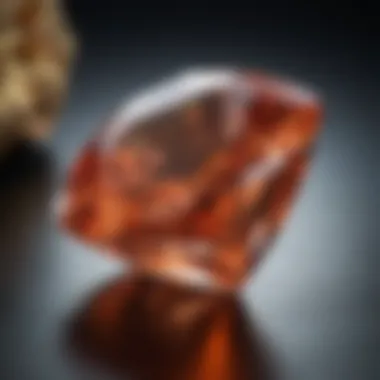
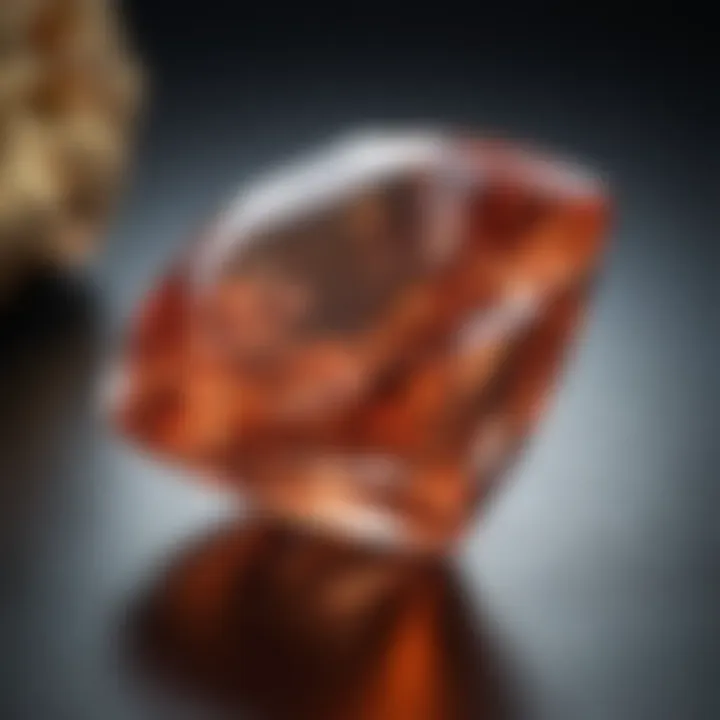
- Paraiba Tourmaline: Known for its striking neon blue to green hues.
- Watermelon Tourmaline: Displays a combination of pink and green, resembling the fruit it's named after.
- Rubellite: A deep red to pink variety that captures attention with its vibrant color.
- Indicolite: Presents a captivating blue shade that can range from light to dark tones.
Each color not only appeals visually but also carries specific meanings and associations. For instance, green tourmaline is often linked with abundance, while blue tourmaline is said to promote serenity. This spectrum allows individuals to choose a stone that resonates with their personal preferences or emotional needs.
Tourmaline's Unique Crystal Structure
Tourmaline features a complex crystal structure that contributes significantly to its distinct appearance. Composed of elongated, trigonal crystals, it can exhibit striations along its length. These striations often appear as thin lines on the surface, enhancing its visual appeal.
The unique structure results in its notable pleochroism, meaning it can display different colors when viewed from different angles. This optical phenomenon can make a single tourmaline stone appear multifaceted, appealing to collectors and jewelry designers alike.
In summary, tourmaline's vibrancy and structural characteristics not only elevate its status as a birthstone but also offer profound benefits and lore that capture the interest of many. Understanding these features enriches the experience of owning or gifting this gemstone, making it more than just a decorative piece.
Cultural Significance of October Birthstones
The cultural significance of October birthstones extends beyond their aesthetic value. This section aims to highlight how opal and tourmaline have been interpreted historically and socially, particularly related to individuals born in October. Such understanding provides gemstone enthusiasts and collectors with deeper insights into their significance and potential influence on personal identity.
Historical Beliefs Surrounding Opal
Opal has long been surrounded by a veil of mythology. In ancient Rome, opals were regarded as a stone of hope and purity. Women of great status adorned themselves with opals, believing that the stone would bring them luck and protection. The Greeks considered opal to be a gift from the gods, capable of granting foresight and the ability to predict the future. Similarly, in the Middle Ages, it was thought that opals possessed powers of invisibility.
This gemstone's iridescence often led to varied interpretations, depending on the era and culture. In the 19th century, opals gained notoriety due to a popular novel that portrayed them as harbingers of misfortune. However, its allure remained intact, and opal enthusiasts recognize the gem's complex yet fascinating history in the craftsmanship of jewelry.
Tourmaline in Ancient Cultures
Tourmaline's cultural importance in ancient civilizations is notable. It was highly valued by various cultures, particularly in Africa and Asia. In ancient Egypt, tourmaline was believed to be the stone of the first chakra, embodying the energy of the Earth. This belief stemmed from the stone's ability to attract energy and its wide range of colors.
Many ancient cultures also utilized tourmaline for its reported healing properties. Native American tribes viewed it as a protective stone, using it in their rituals and crafts. The diverse colors of tourmaline were thought to represent a spectrum of emotions and energies, impacting the wearer's spiritual and physical well-being.
Modern Interpretations of October Stones
In contemporary times, interpreters of October birthstones often highlight a balance between the aesthetic and the metaphysical. Opal is frequently associated with creativity and inspiration, influencing artists and thinkers alike. Tourmaline, on the other hand, is often recognized for its protective qualities, promoting a sense of grounding and stability in one's life.
People today may choose to wear these stones not only for their beauty but also for their purported benefits. The connection to personal identity can be profound; individuals often report feeling a sense of empowerment with the presence of these stones in their lives.
"Understanding the cultural significance of birthstones allows individuals to connect with their chosen gem on a deeper level."
In summary, the cultural significance of October birthstones is multifaceted. The historical beliefs surrounding opal and tourmaline, their roles in ancient cultures, and the modern interpretations reflect a continuous evolution of thought regarding these gemstones. This knowledge enriches the experience of gemstone enthusiasts and collectors, as they appreciate the interwoven narratives that characterize opal and tourmaline.
Metaphysical Properties of Opal and Tourmaline
The metaphysical properties of Opal and Tourmaline play a significant role in understanding their value beyond physical beauty. For collectors and gemstone enthusiasts, these attributes often enhance the appeal of these stones. These properties are rooted in cultural beliefs, personal experiences, and anecdotal evidence that suggest these gems carry distinct energies affecting emotional and spiritual well-being.
Understanding these metaphysical aspects can provide deeper insight into why individuals choose these stones and how they incorporate them into their lives. This knowledge can guide users in selecting gemstones that resonate with their personal journeys or meet specific emotional needs.
Opal: Healing and Emotional Benefits
Opal is often associated with various healing and emotional benefits. One of its primary qualities is its ability to enhance one's emotional sensitivity. Many believe that opal can amplify feelings of joy and passion but also draw out fears and anxieties, making it a double-edged sword. This clarity can lead to meaningful personal growth.
People often use Opal to promote creativity. It is thought to inspire imagination and allows individuals to connect with their inherent artistic abilities. Some also regard opal as a stone of protection, which can shield the wearer from negative influences and encourage a sense of inner calm.
Key healing aspects of Opal include:
- Emotional healing: Helps release old patterns to promote emotional balance.
- Creativity enhancement: Encourages artistic self-expression.
- Protection: Acts as a barrier against negativity.


Opal's shifting colors may reflect the wearer's emotional state, allowing for self-reflection and deeper understanding.
Tourmaline: Protective and Grounding Qualities
Tourmaline is celebrated for its protective and grounding qualities. This gemstone is particularly valued for its ability to absorb and repel negative energies. Many users feel more stable and secure when wearing tourmaline, making it a popular choice in stressful environments. The wide range of colors in tourmaline also corresponds to different healing properties, which can be tailored to individual needs.
This stone is often used in meditation practices because it is believed to connect the physical and spiritual worlds. This connection can provide clarity and tranquility, enhancing the overall spiritual experience.
Key protective aspects of Tourmaline include:
- Energy shielding: Protects the wearer against electromagnetic pollution.
- Emotional stability: Eases stress and promotes equilibrium.
- Spiritual grounding: Aids in meditation and spiritual connection.
Selecting and Caring for October Birthstones
Choosing the right birthstone can be a significant act. Birthstones like opal and tourmaline hold impressive qualities and historical stories. Understanding how to select these stones wisely enhances their value both personally and financially. Several elements come into play when deciding which gemstone to acquire.
Factors to Consider When Choosing Gemstones
When selecting opal or tourmaline, certain aspects should be paramount in your decision-making process:
- Type and Quality: Not all opals or tourmalines are created equal. Each type has unique qualities. White opals tend to be more common while black opals are rarer and often more expensive. Similarly, tourmaline comes in many colors that may affect their desirability and price.
- Purpose: Clarify why you want the gemstone. Is it for jewelry, collection, or metaphysical purposes? Knowing this can guide you to the right choice.
- Authenticity: Ensure that you are buying genuine stones. Verify the seller's credibility. Look for certifications or independent appraisals when necessary.
- Visual Appeal: Each gemstone has a unique aesthetic. Look at how the colors and patterns resonate with you. Emotional connection can enhance your appreciation for the piece.
- Budget Consideration: High-quality opal and tourmaline can be costly. Determine your financial limits before beginning your search. This will keep you focused on options that are both suitable and affordable.
Maintenance of Opal and Tourmaline
Proper care for opals and tourmalines ensures their natural beauty preserves over time. Understanding their care requirements helps maintain their appeal and value.
- Cleaning: Both gemstones can be cleaned lightly with a damp cloth. Avoid exposing them to harsh chemicals or ultrasonic cleaners. These can cause damage.
- Storage: Store each gemstone separately to prevent scratches. Soft cloth pouches or padded boxes are ideal.
- Avoiding Extreme Conditions: Extreme temperatures can crack opals. Similarly, tourmaline can lose its color if left in direct sunlight for extended periods. Maintain stable environmental conditions for these stones.
- Regular Checks: Periodically examine the gemstone for any changes or damage. Early detection can facilitate easier repairs if needed.
Regular maintenance enhances the longevity and beauty of your gemstones. Caring for opals and tourmalines not only preserves their aesthetic value but also retains their significance.
In summary, selecting and taking care of September birthstones is a thoughtful endeavor that can yield significant satisfaction and enjoyment. By focusing on the mentioned factors and consistently maintaining their condition, enthusiasts can cherish their gemstones for years to come.
Finale: The Essence of October Birthstones
The conclusion of this article underscores the multifaceted significance of October birthstones, particularly focusing on opal and tourmaline. These gemstones are not only visually striking but also rich in history and symbolism. Understanding their characteristics helps individuals make not just aesthetic choices but deeply personal decisions.
Selecting a birthstone involves more than simply choosing a colorful gem. It is about reflecting personal identity, honoring heritage, and embracing the emotional and metaphysical attributes associated with each stone. For gemstone enthusiasts, collectors, and jewelry designers, each piece can tell a profound story, connecting the bearer to a lineage that spans generations.
Moreover, the cultural and historical contexts discussed throughout the article enrich the personal connection one might have with a specific birthstone. Recognizing the traditional beliefs and modern interpretations can cultivate a deeper appreciation for these gems. This context heightens the experience of ownership and allows for informed selection based on both aesthetic preference and cultural significance.
Final Thoughts on Gemstone Selection
When choosing a gemstone, one must consider several factors: the stone's properties, the personal resonance it may have, and practical considerations like durability and care requirements. For October's opal and tourmaline, understanding their distinct characteristics is vital.
- Opal: Known for its play-of-color, its breathtaking array of hues can captivate an audience.
- Tourmaline: Its variety in colors represents a broader spectrum of personal expression.
Factors to consider include:
- Personal meaning: What does this stone represent?
- Style compatibility: How will it fit with existing jewelry?
- Durability: Especially important for everyday wear.
Investing in these stones means selecting a piece that will not only enhance one's collection but also serve as a valuable family heirloom, passed down through the ages.
Embracing Personal Connection to Birthstones
A gemstone has the unique ability to form a bond with its wearer. This emotional connection can be cultivated through an understanding of not just the stone's physical attributes but also its metaphysical qualities. Many believe that wearing a birthstone brings positive energy and attunes the bearer to their true self.
Consideration of personal beliefs plays a significant role in this relationship. Whether one sees opal as a source of creativity and inspiration or tourmaline as a protective shield against negativity, awareness of these properties deepens the bond.
The ownership of a birthstone, especially for those born in October, can symbolize unity, resilience, and connection to otherworldly realms. Adopting this mindset when selecting and wearing a gemstone creates a significant impact, transforming a simple decorative item into a personal talisman.



